
The silver Y is a migratory moth of the family Noctuidae which is named for the silvery Y-shaped mark on each of its forewings.

Autographa is a genus of moths of the family Noctuidae.

Autographa californica, the alfalfa looper, is a moth of the family Noctuidae. The species was first described by Adolph Speyer in 1875. It is found in western North America from southern British Columbia to Baja California and to Manitoba, South Dakota, Colorado and New Mexico.
Lophosis is a monotypic geometrid moth genus. Its only species, Lophosis labeculata, the stained lophosis moth, is found in North America. Both the genus and species were first described by George Duryea Hulst, the genus in 1896 and the species in 1887.

Autographa ampla, the large looper moth, raspberry looper, brown-patched looper or broken-banded Y, is a moth of the family Noctuidae. The species was first described by Francis Walker in 1858. It is found in North America from Newfoundland west to the Alaska panhandle, south to central California, Arizona and New Mexico in the west and North Carolina in the east.
Autographa bimaculata, the two-spotted looper moth, twin gold spot or double-spotted spangle, is a moth of the family Noctuidae. The species was first described by James Francis Stephens in 1830. It is found in North America from Newfoundland west, just short of the coast of British Columbia, north to the Northwest Territories and south to New Mexico in the west and Pennsylvania and Long Island in the east.
Autographa flagellum, the silver whip, is a moth of the family Noctuidae. The species was first described by Francis Walker in 1858. It is found in North America from Newfoundland west across southern Canada to south-eastern British Columbia, south in the east to Maine, Michigan and Wisconsin. There are isolated reports from further south.
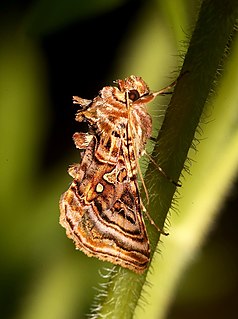
Autographa mappa, the wavy chestnut Y, is a moth of the family Noctuidae. The species was first described by Augustus Radcliffe Grote and Coleman Townsend Robinson in 1868. It is found in North America from Newfoundland west across the wooded portions of Canada to Vancouver Island, south in the east to Maine, New Hampshire and Wisconsin, and in the western mountains south to Colorado and Oregon.
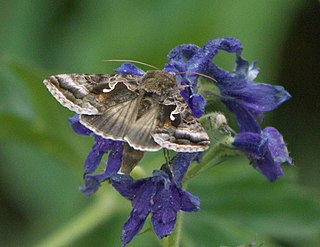
Autographa pseudogamma, the delicate silver Y, is a moth of the family Noctuidae. The species was first described by Augustus Radcliffe Grote in 1875. It is found in North America from Newfoundland to coastal northern Alaska, south in the east to New England and in the western mountains to New Mexico, Arizona and California. It is also found in the Cypress Hills and the Black Hills of South Dakota.
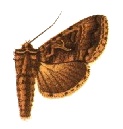
Autographa rubida is a moth of the family Noctuidae first described by Rodrigues Ottolengui in 1902. It is found from Newfoundland west across southern Canada to south-eastern British Columbia, south to Maine and Minnesota.

Autographa sansoni, the Alberta beauty, is a moth of the family Noctuidae. The species was first described by F. H. Wolley Dod in 1910. It is found in the western mountains of North America, from Alaska south to Oregon, Idaho and Arizona. Occurring mainly in the Pacific Northwest, it thrives in mid-to-high elevation conifer forest habitat, as well as some areas of coastal rain forest in the Coast range. However, it is also found in a non-contiguous range in sub-alpine forest in the Rocky Mountains, ranging from Alberta in the north, to New Mexico in the south. The wingspan of an adult ranges between 34 and 36 mm. It is widespread, and a relatively common species.
Grapholita delineana, known generally as Eurasian hemp moth, is a species of tortricid moth in the family Tortricidae. Other common names include the hemp moth and hemp borer.
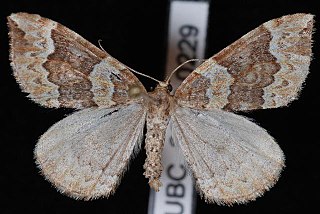
Eulithis destinata is a species of geometrid moth in the family Geometridae. It is found in North America.
Metarranthis pilosaria, known generally as the coastal bog metarranthi or slender groundsel moth, is a species of geometrid moth in the family Geometridae. It is found in North America.
Melipotis novanda is an owlet moth in the family Erebidae first described by Achille Guenée in 1852. It is found in North America.
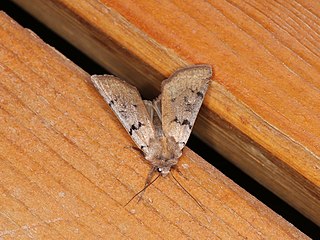
Richia parentalis is a species of cutworm or dart moth in the family Noctuidae. It is found in North America.

Panopoda rufimargo, the red-lined panopoda, is an owlet moth in the family Erebidae. The species was first described by Jacob Hübner in 1818. It is found in North America.
Eupsilia cirripalea, or Franclemont's sallow, is a species of cutworm or dart moth in the family Noctuidae. It is found in North America.
Litodonta wymola is a species of moth in the family Notodontidae. It was first described by William Barnes in 1905 and it is found in North America.
Autographa pasiphaeia is a species of looper moth in the family Noctuidae. It is found in North America.









